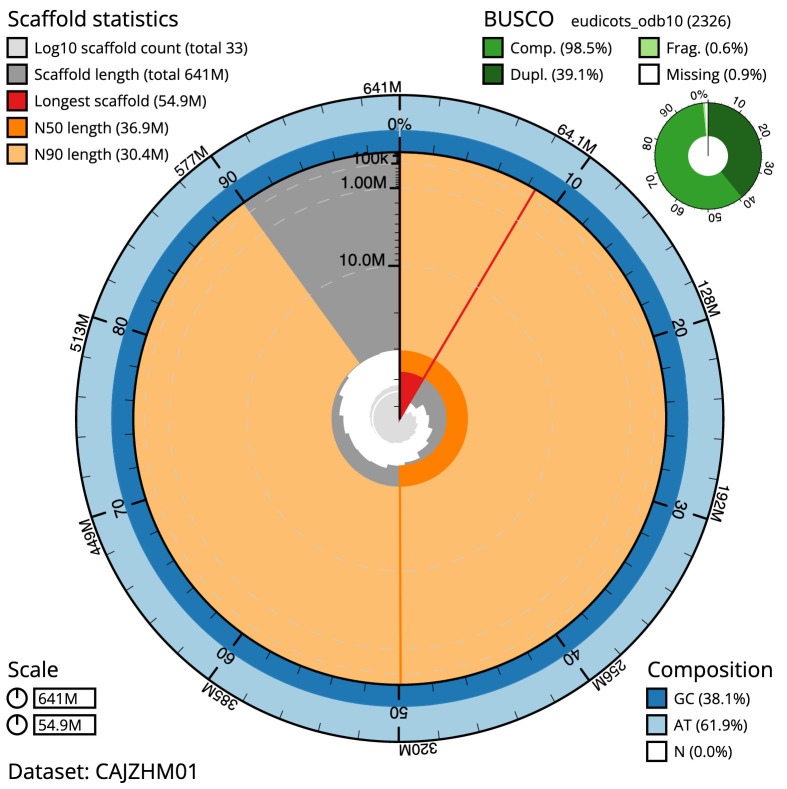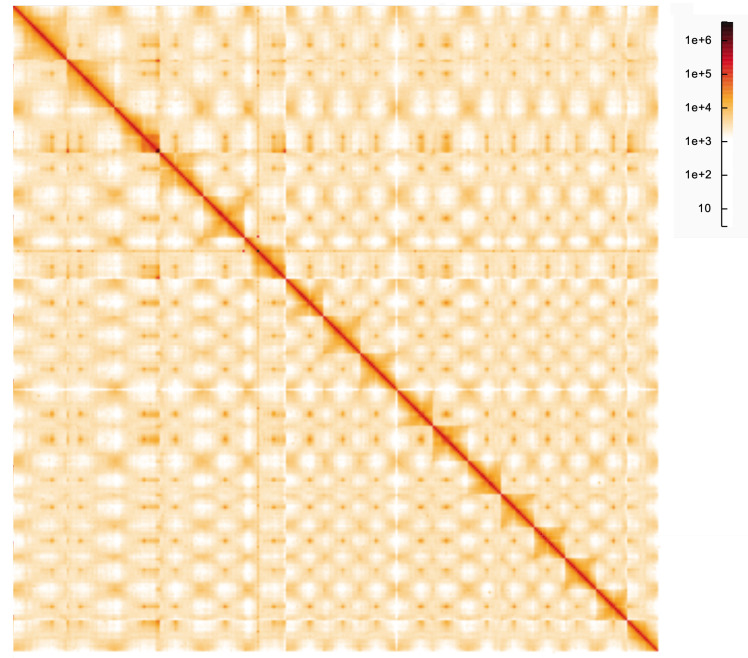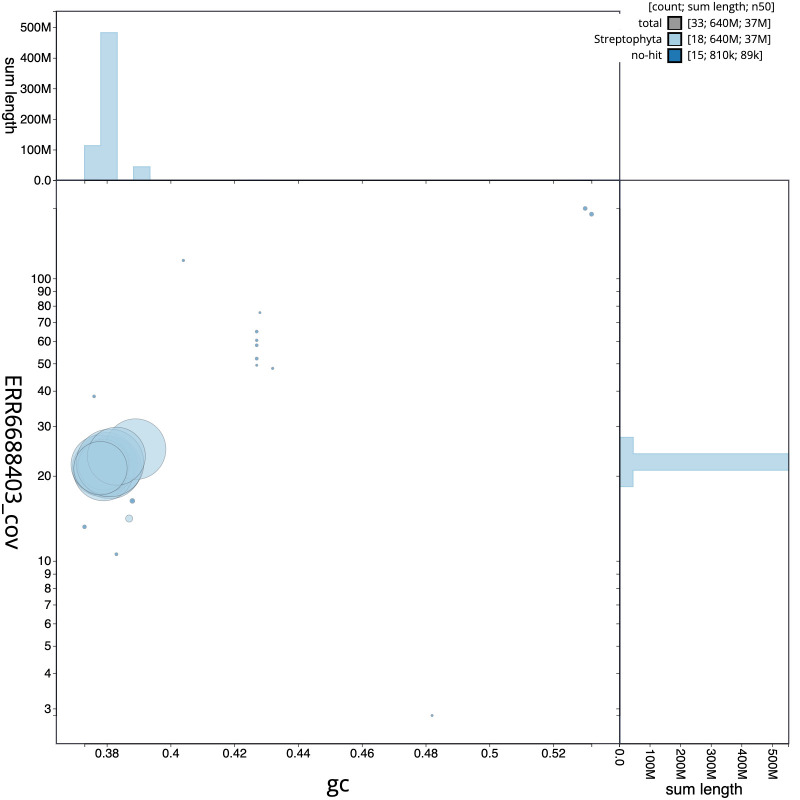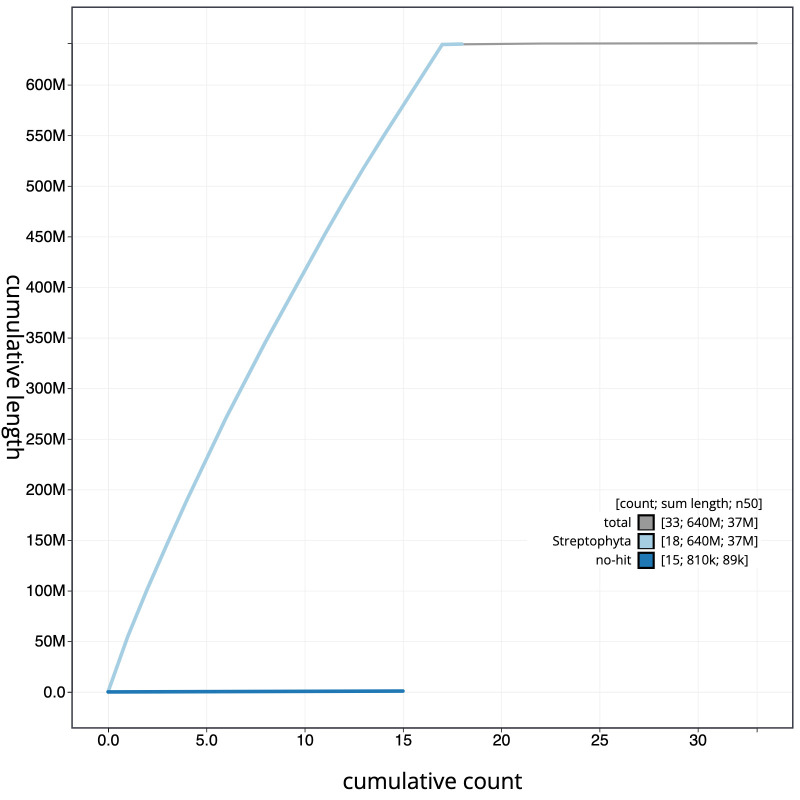Abstract
We present a genome assembly from an individual Malus sylvestris (the European or 'wild' crab apple; Streptophyta; Magnoliopsida; Rosales; Rosaceae). The genome sequence is 642 megabases in span. Most of the assembly (99.98%) is scaffolded into 17 chromosomal pseudomolecules. The mitochondrial and chloroplast genomes were also assembled, with respective lengths of 396.9 kilobases and 160.0 kilobases.
Keywords: Malus sylvestris, European crab apple, genome sequence, chromosomal, Rosaceae
Species taxonomy
Eukaryota; Viridiplantae; Streptophyta; Embryophyta; Tracheophyta; Spermatophyta; Magnoliopsida; eudicotyledons; Gunneridae; Pentapetalae; rosids; fabids; Rosales; Rosaceae; Amygdaloideae; Maleae; Malus; Malus sylvestris (L.) Mill., 1768 (NCBI:txid3752).
Background
Malus sylvestris (European wild or crab apple) belongs to the Rose family (Rosaceae) and is a small tree native across Europe. It reaches its north-western distribution limit in Scotland and Norway and is probably the UK’s least understood and most under-appreciated tree, as even foresters sometimes do not seem to be aware of its native status. There is evidence of its longstanding use, as wild apples have been found at Neolithic and Bronze Age archaeological sites across Europe ( Cornille et al. 2014). Additionally, without the European wild apple, the eating apples so many people love would not be quite the same. It is one of the main contributors to the domesticated apple, M. domestica ( Cornille et al., 2014; Cornille et al., 2019). The widely planted cultivated varieties of M. domestica continue to hybridise with the wild apple trees, causing concern that the genetic integrity of M. sylvestris might be eroded in the long run ( Cornille et al., 2013; Feurtey et al., 2017; Ruhsam et al., 2019; Schnitzler et al., 2014).
In a recent study, nearly 30% of the wild apple trees genotyped turned out to be of hybrid origin ( Ruhsam et al., 2019). As morphological identification of hybrid trees is difficult, access to the full genome of both M. sylvestris and M. domestica will facilitate the development of genome-wide species-specific markers, enabling the reliable assessment of levels of introgression in the European wild apple.
The genome of the European crab apple, M. sylvestris, was sequenced as part of the Darwin Tree of Life Project, a collaborative effort to sequence all named eukaryotic species in the Atlantic Archipelago of Britain and Ireland.
Genome sequence report
The genome was sequenced from a single M. sylvestris (hermaphroditic) ( Figure 1), collected from Glen Falloch, Scotland, UK. A total of 25-fold coverage in Pacific Biosciences single-molecule HiFi long reads and 87-fold coverage in 10X Genomics read clouds were generated. Primary assembly contigs were scaffolded with chromosome conformation Hi-C data. Manual assembly curation corrected 64 missing/misjoins and removed 10 haplotypic duplications, reducing the assembly size by 0.17% and the scaffold number by 36.0%.
Figure 1. Image of the Malus sylvestris specimen from which samples used for sequencing were taken.
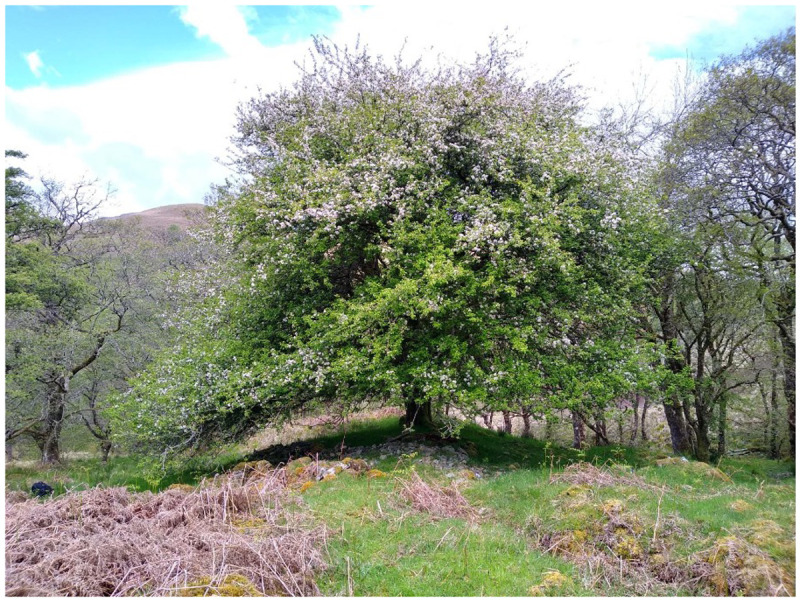
The drMalSylv7 leaf samples were used to generate PacBio, 10X genomics and Hi-C data.
The final assembly has a total length of 641 Mb in 32 sequence scaffolds with a scaffold N50 of 36.9 Mb ( Table 1). Most of the assembled sequence (99.98%) was assigned to 17 chromosomal-level scaffolds numbered by synteny based on Malus domestica (apple) GCA_004115385.1 ( Figure 2– Figure 5; Table 2).
Figure 2. Genome assembly of Malus sylvestris, drMalSylv7.1: metrics.
The BlobToolKit Snailplot shows N50 metrics and BUSCO gene completeness. The main plot is divided into 1,000 size-ordered bins around the circumference with each bin representing 0.1% of the 640,986,597 bp assembly. The distribution of chromosome lengths is shown in dark grey with the plot radius scaled to the longest chromosome present in the assembly (54,898,662 bp, shown in red). Orange and pale-orange arcs show the N50 and N90 chromosome lengths (36,902,754 and 30,380,474 bp), respectively. The pale grey spiral shows the cumulative chromosome count on a log scale with white scale lines showing successive orders of magnitude. The blue and pale-blue area around the outside of the plot shows the distribution of GC, AT and N percentages in the same bins as the inner plot. A summary of complete, fragmented, duplicated and missing BUSCO genes in the eudicots_odb10 set is shown in the top right. An interactive version of this figure is available at https://blobtoolkit.genomehubs.org/view/drMalSylv7.1/dataset/CAJZHM01/snail.
Figure 5. Genome assembly of Malus sylvestris, drMalSylv7.2: Hi-C contact map.
Hi-C contact map of the drMalSylv7.2 assembly, visualised in HiGlass. Chromosomes are arranged in size order from left to right and top to bottom. The interactive Hi-C map can be viewed at https://genome-note-higlass.tol.sanger.ac.uk/l/?d=FgGkT9v7SR2otUnBK-HkfQ.
Table 1. Genome data for Malus sylvestris, drMalSylv7.2.
| Project accession data | |
|---|---|
| Assembly identifier | drMalSylv7.2 |
| Species | Malus sylvestris |
| Specimen | drMalSylv7 (genome
assembly, Hi-C) |
| NCBI taxonomy ID | 3752 |
| BioProject | PRJEB47316 |
| BioSample ID | SAMEA9197672 |
| Isolate information | Leaf tissue |
| Raw data accessions | |
| PacificBiosciences SEQUEL II | ERR6808038, ERR6808039 |
| 10X Genomics Illumina | ERR6688721-ERR6688723;
ERR6688403 |
| Hi-C Illumina | ERR6688724 |
| Standard Illumina libraries | ERR6909395-ERR6909404 |
| Genome assembly | |
| Assembly accession | GCA_916048215.2 |
| Accession of alternate haplotype | GCA_916049865.1 |
| Span (Mb) | 641 |
| Number of contigs | 133 |
| Contig N50 length (Mb) | 8.3 |
| Number of scaffolds | 32 |
| Scaffold N50 length (Mb) | 36.9 |
| Longest scaffold (Mb) | 54.9 |
| BUSCO * genome score | C:98.5%[S:59.4%,D:39.1%],
F:0.6%,M:0.9%,n:2,326 |
*BUSCO scores based on the eudicots_odb10 BUSCO set using v5.3.2. C = complete [S = single copy, D = duplicated], F = fragmented, M = missing, n = number of orthologues in comparison. A full set of BUSCO scores is available at https://blobtoolkit.genomehubs.org/view/drMalSylv7.1/dataset/CAJZHM01/busco.
Figure 3. Genome assembly of Malus sylvestris, drMalSylv7.1: GC coverage.
BlobToolKit GC-coverage plot. Scaffolds are coloured by phylum. Circles are sized in proportion to scaffold length. Histograms show the distribution of scaffold length sum along each axis. An interactive version of this figure is available at https://blobtoolkit.genomehubs.org/view/drMalSylv7.1/dataset/CAJZHM01/blob.
Figure 4. Genome assembly of Malus sylvestris, drMalSylv7.1: cumulative sequence.
BlobToolKit cumulative sequence plot. The grey line shows cumulative length for all scaffolds. Coloured lines show cumulative lengths of scaffolds assigned to each phylum using the buscogenes taxrule. An interactive version of this figure is available at https://blobtoolkit.genomehubs.org/view/drMalSylv7.1/dataset/CAJZHM01/cumulative.
Table 2. Chromosomal pseudomolecules in the genome assembly of Malus sylvestris, drMalSylv7.2.
Chromosome-scale scaffolds are numbered by synteny based on Malus domestica (apple) GCA_004115385.1.
| INSDC accession | Name | Size (Mb) | GC% |
|---|---|---|---|
| OU696503.1 | 1 | 30.13 | 38.3 |
| OU696504.1 | 2 | 37.96 | 37.8 |
| OU696505.1 | 3 | 36.9 | 38 |
| OU696506.1 | 4 | 31.14 | 38 |
| OU696507.1 | 5 | 47.13 | 38.1 |
| OU696508.1 | 6 | 34.96 | 38 |
| OU696509.1 | 7 | 35.53 | 37.9 |
| OU696510.1 | 8 | 30.37 | 37.9 |
| OU696511.1 | 9 | 35.18 | 38.1 |
| OU696512.1 | 10 | 43.2 | 37.9 |
| OU696513.1 | 11 | 41.35 | 37.8 |
| OU696514.1 | 12 | 32.55 | 37.9 |
| OU696515.1 | 13 | 44.07 | 38.9 |
| OU696516.1 | 14 | 30.38 | 37.9 |
| OU696517.1 | 15 | 54.9 | 38.1 |
| OU696518.1 | 16 | 40.12 | 38.3 |
| OU696519.1 | 17 | 33.87 | 37.8 |
| - | MT | 0.4 | 45.4 |
| - | Pltd | 0.16 | 36.6 |
| - | unplaced | 1.23 | 41.7 |
Shared sequences between chromosomes are visible in the Hi-C map in agreement with the findings of ( Velasco et al., 2010) for Malus domestica. The Hi-C map provides evidence of inversions between haplotypes in chromosome 2 (24.82–26.19 Mb), and chromosome 11 (17.06–19.05 Mb). There are several scaffolds that it was possible to localise to a chromosome but not place, and these have been labelled as ‘unloc’. Two of the largest unlocalised scaffolds – SUPER_4_unloc_1 and SUPER_14_unloc_1 – appear to be larger haplotypes of two specific loci: Chromosome 4 at ~26.13–26.31 Mb and chromosome 14 at ~782 kb respectively. From the Hi-C it appears that these loci currently represent the shorter haplotype. As there is some uncertainty over these unlocalised scaffolds, they were left in the primary assembly.
The assembly has a BUSCO v5.3.2 ( Manni et al., 2021) completeness of 98.5% (single 59.4%, duplicated 39.1%) using the eudicots_odb10 reference set ( n = 2,326). While not fully phased, the assembly deposited is of one haplotype. Contigs corresponding to the second haplotype have also been deposited.
Methods
Sample acquisition and nucleic acid extraction
Leaf samples from a single M. sylvestris specimen (drMalSylv7; genome assembly, Hi-C) were collected from Glen Falloch, Scotland, UK (latitude 56.343794, longitude –4.7078054) by Markus Ruhsam (Royal Botanic Garden Edinburgh), who also identified the specimen. The leaf samples were picked by hand, cut and put into FluidX tubes, then snap-frozen in liquid nitrogen.
The drMalSylv7 leaf sample was weighed and dissected on dry ice with tissue set aside for Hi-C sequencing. Leaf tissue was cryogenically disrupted to a fine powder using a Covaris cryoPREP Automated Dry Pulveriser, receiving multiple impacts. High molecular weight (HMW) DNA was extracted using the Qiagen Plant MagAttract HMW DNA extraction kit. Low molecular weight DNA was removed from a 200 ng aliquot of extracted DNA using 0.8X AMpure XP purification kit prior to 10X Chromium sequencing; a minimum of 50 ng DNA was submitted for 10X sequencing. HMW DNA was sheared into an average fragment size of 12–20 kb in a Megaruptor 3 system with speed setting 30. Sheared DNA was purified by solid-phase reversible immobilisation using AMPure PB beads with a 1.8X ratio of beads to sample to remove the shorter fragments and concentrate the DNA sample. The concentration of the sheared and purified DNA was assessed using a Nanodrop spectrophotometer and Qubit Fluorometer and Qubit dsDNA High Sensitivity Assay kit. Fragment size distribution was evaluated by running the sample on the FemtoPulse system.
Sequencing
Pacific Biosciences HiFi circular consensus and 10X Genomics Chromium read cloud sequencing libraries were constructed according to the manufacturers’ instructions. Sequencing was performed by the Scientific Operations core at the Wellcome Sanger Institute on Pacific Biosciences SEQUEL II (HiFi) and Illumina NovaSeq 6000 (10X) instruments. Hi-C data were generated in the Tree of Life laboratory from remaining leaf tissue of drMalSylv7 using the Arima v2 kit and sequenced on a NovaSeq 6000 instrument. Standard read sequencing libraries were generated using an Illumina NovaSeq 6000 (10X) instrument, as per the manufacturer’s instructions.
Genome assembly
Assembly was carried out with Hifiasm ( Cheng et al., 2021) and haplotypic duplication was identified and removed with purge_dups ( Guan et al., 2020). One round of polishing was performed by aligning 10X Genomics read data to the assembly with longranger align, calling variants with freebayes ( Garrison & Marth, 2012). The assembly was then scaffolded with Hi-C data ( Rao et al., 2014) using SALSA2 ( Ghurye et al., 2019). The assembly was checked for contamination as described previously ( Howe et al., 2021). Manual curation was performed using HiGlass ( Kerpedjiev et al., 2018) and Pretext ( Harry, 2022). The mitochondrial and plastid genomes were assembled using MBG ( Rautiainen & Marschall, 2021) from PacBio HiFi reads mapping to related genomes. A representative circular sequence was selected for each from the graph based on read coverage. The genome was analysed and BUSCO scores were generated within the BlobToolKit environment ( Challis et al., 2020). Table 3 contains a list of the software tool versions used, where appropriate.
Table 3. Software tools used.
| Software
tool |
Version | Source |
|---|---|---|
| Hifiasm | 0.15.3-r339 | Cheng et al., 2021 |
| purge_dups | 1.2.3 | Guan et al., 2020 |
| SALSA2 | 2.2 | Ghurye et al., 2019 |
| longranger
align |
2.2.2 |
https://support.10xgenomics.com/
genome-exome/software/pipelines/ latest/advanced/other-pipelines |
| freebayes | 1.3.1-17-
gaa2ace8 |
Garrison & Marth, 2012 |
| HiGlass | 1.11.6 | Kerpedjiev et al., 2018 |
| PretextView | 0.2.x | Harry, 2022 |
| BlobToolKit | 3.2.9 | Challis et al., 2020 |
Ethics/compliance issues
The materials that have contributed to this genome note have been supplied by a Darwin Tree of Life Partner. The submission of materials by a Darwin Tree of Life Partner is subject to the Darwin Tree of Life Project Sampling Code of Practice. By agreeing with and signing up to the Sampling Code of Practice, the Darwin Tree of Life Partner agrees they will meet the legal and ethical requirements and standards set out within this document in respect of all samples acquired for, and supplied to, the Darwin Tree of Life Project. Each transfer of samples is further undertaken according to a Research Collaboration Agreement or Material Transfer Agreement entered into by the Darwin Tree of Life Partner, Genome Research Limited (operating as the Wellcome Sanger Institute), and in some circumstances other Darwin Tree of Life collaborators.
Funding Statement
This work was supported by Wellcome through core funding to the Wellcome Sanger Institute (206194, <a href=https://doi.org/10.35802/206194>https://doi.org/10.35802/206194</a>) and the Darwin Tree of Life Discretionary Award (218328, <a href=https://doi.org/10.35802/218328>https://doi.org/10.35802/218328</a>).
The funders had no role in study design, data collection and analysis, decision to publish, or preparation of the manuscript.
[version 1; peer review: 2 approved]
Data availability
European Nucleotide Archive: Malus sylvestris (European crab apple). Accession number PRJEB47316; https://identifiers.org/ena.embl/PRJEB47316 ( Wellcome Sanger Institute, 2022)
The genome sequence is released openly for reuse. The M. sylvestris genome sequencing initiative is part of the Darwin Tree of Life (DToL) project. All raw sequence data and the assembly have been deposited in INSDC databases. The genome will be annotated and presented through the Ensembl pipeline at the European Bioinformatics Institute. Raw data and assembly accession identifiers are reported in Table 1.
Author information
Members of the Royal Botanic Garden Edinburgh Genome Acquisition Lab are listed here: https://doi.org/10.5281/zenodo.4786682.
Members of the Darwin Tree of Life Barcoding collective are listed here:
https://doi.org/10.5281/zenodo.4893703.
Members of the Wellcome Sanger Institute Tree of Life programme are listed here:
https://doi.org/10.5281/zenodo.4783585.
Members of Wellcome Sanger Institute Scientific Operations: DNA Pipelines collective are listed here: https://doi.org/10.5281/zenodo.4790455.
Members of the Tree of Life Core Informatics collective are listed here:
https://doi.org/10.5281/zenodo.5013541.
Members of the Darwin Tree of Life Consortium are listed here:
References
- Challis R, Richards E, Rajan J, et al. : BlobToolKit - interactive quality assessment of genome assemblies. G3 (Bethesda). 2020;10(4):1361–1374. 10.1534/g3.119.400908 [DOI] [PMC free article] [PubMed] [Google Scholar]
- Cheng H, Concepcion GT, Feng X, et al. : Haplotype-resolved de novo assembly using phased assembly graphs with hifiasm. Nat Methods. 2021;18(2):170–175. 10.1038/s41592-020-01056-5 [DOI] [PMC free article] [PubMed] [Google Scholar]
- Cornille A, Antolín F, Garcia E, et al. : A Multifaceted Overview of Apple Tree Domestication. Trends Plant Sci. Elsevier Ltd,2019;24(8):770–782. 10.1016/j.tplants.2019.05.007 [DOI] [PubMed] [Google Scholar]
- Cornille A, Giraud T, Smulders MJM, et al. : The domestication and evolutionary ecology of apples. Trends Genet. Elsevier Ltd,2014;30(2):57–65. 10.1016/j.tig.2013.10.002 [DOI] [PubMed] [Google Scholar]
- Cornille A, Gladieux P, Giraud T: Crop-to-wild gene flow and spatial genetic structure in the closest wild relatives of the cultivated apple. Evol Appl. 2013;6(5):737–748. 10.1111/eva.12059 [DOI] [PMC free article] [PubMed] [Google Scholar]
- Feurtey A, Cornille A, Shykoff JA, et al. : Crop-to-wild gene flow and its fitness consequences for a wild fruit tree: Towards a comprehensive conservation strategy of the wild apple in Europe. Evol Appl. 2017;10(2):180–188. 10.1111/eva.12441 [DOI] [PMC free article] [PubMed] [Google Scholar]
- Garrison E, Marth G: Haplotype-based variant detection from short-read sequencing.2012. Reference Source [Google Scholar]
- Ghurye J, Rhie A, Walenz BP, et al. : Integrating Hi-C links with assembly graphs for chromosome-scale assembly. PLoS Comput Biol. 2019;15(8):e1007273. 10.1371/journal.pcbi.1007273 [DOI] [PMC free article] [PubMed] [Google Scholar]
- Guan D, McCarthy SA, Wood J, et al. : Identifying and removing haplotypic duplication in primary genome assemblies. Bioinformatics. 2020;36(9):2896–2898. 10.1093/bioinformatics/btaa025 [DOI] [PMC free article] [PubMed] [Google Scholar]
- Harry E: PretextView (Paired REad TEXTure Viewer): A desktop application for viewing pretext contact maps.2022; (Accessed: 19 October 2022). Reference Source [Google Scholar]
- Howe K, Chow W, Collins J, et al. : Significantly improving the quality of genome assemblies through curation. GigaScience. Oxford University Press.2021;10(1):giaa153. 10.1093/gigascience/giaa153 [DOI] [PMC free article] [PubMed] [Google Scholar]
- Kerpedjiev P, Abdennur N, Lekschas F, et al. : HiGlass: Web-based visual exploration and analysis of genome interaction maps. Genome Biol. 2018;19(1):125. 10.1186/s13059-018-1486-1 [DOI] [PMC free article] [PubMed] [Google Scholar]
- Manni M, Berkeley MR, Seppey M, et al. : BUSCO Update: Novel and Streamlined Workflows along with Broader and Deeper Phylogenetic Coverage for Scoring of Eukaryotic, Prokaryotic, and Viral Genomes. Mol Biol Evol. 2021;38(10):4647–4654. 10.1093/molbev/msab199 [DOI] [PMC free article] [PubMed] [Google Scholar]
- Rao SSP, Huntley MH, Durand NC, et al. : A 3D map of the human genome at kilobase resolution reveals principles of chromatin looping. Cell. 2014;159(7):1665–1680. 10.1016/j.cell.2014.11.021 [DOI] [PMC free article] [PubMed] [Google Scholar]
- Rautiainen M, Marschall T: MBG: Minimizer-based sparse de Bruijn Graph construction. Bioinformatics. 2021;37(16):2476–2478. 10.1093/bioinformatics/btab004 [DOI] [PMC free article] [PubMed] [Google Scholar]
- Ruhsam M, Jessop W, Cornille A, et al. : Crop-to-wild introgression in the European wild apple Malus sylvestris. in Northern Britain. Forestry: An International Journal of Forest Research. 2019;92(1):85–96. 10.1093/forestry/cpy033 [DOI] [Google Scholar]
- Schnitzler A, Arnold C, Cornille A, et al. : Wild European apple ( Malus sylvestris (L.) Mill.) Population dynamics: Insight from genetics and ecology in the Rhine Valley. Priorities for a future conservation programme. PLoS One. 2014;9(5):e96596. 10.1371/journal.pone.0096596 [DOI] [PMC free article] [PubMed] [Google Scholar]
- Velasco R, Zharkikh A, Affourtit J, et al. : The genome of the domesticated apple ( Malus × domestica Borkh.). Nat Genet. 2010;42(10):833–839. 10.1038/ng.654 [DOI] [PubMed] [Google Scholar]
- Wellcome Sanger Institute: The genome sequence of the European crab apple, Malus sylvestris, (L.) Mill, 1768, European Nucleotide Archive [dataset]. accession number PRJEB47316.2022.



